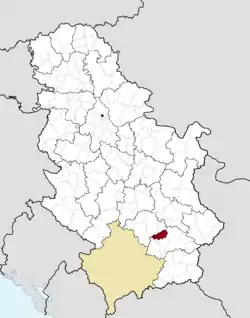Bojnik
Bojnik (Serbian Cyrillic: Бојник) is a village and municipality located in Jablanica District of southern Serbia. According to 2011 census, the population of the village is 6,688 while population of the municipality was 11,073.
Bojnik
Бојник | |
|---|---|
Town and municipality | |
 Bojnik | |
 Coat of arms | |
 Location of the municipality of Bojnik within Serbia | |
| Coordinates: 43°01′N 21°44′E | |
| Country | |
| Region | Southern and Eastern Serbia |
| District | Jablanica |
| Settlements | 36 |
| Government | |
| • Mayor | Nebojša Nenadović (independent) |
| Area | |
| • Town | 9.87 km2 (3.81 sq mi) |
| • Municipality | 264 km2 (102 sq mi) |
| Elevation | 242 m (794 ft) |
| Population (2011 census)[2] | |
| • Town | 6,688 |
| • Town density | 680/km2 (1,800/sq mi) |
| • Municipality | 11,073 |
| • Municipality density | 42/km2 (110/sq mi) |
| Time zone | UTC+1 (CET) |
| • Summer (DST) | UTC+2 (CEST) |
| Postal code | 16205 |
| Area code | +381(0)16 |
| Car plates | LE |
| Website | bojnik |
History
Much of the population settled in after World War II because on 17 February 1942, Bulgarian occupation forces in one day killed all 476 inhabitants of Bojnik, including women, children and the elderly. The massacre was in response to the alleged sheltering of Partisans.[3]
Geography
Bojnik municipality is located in southern Serbia and it is surrounded by municipality of Medveđa in the south-west, municipality of Lebane in the south, municipality of Leskovac in the east, and municipalities of Žitorađa and Prokuplje in the north.
Settlements
Aside from the village of Bojnik, the following villages consist the municipality of Bojnik:
Demographics
| Year | Pop. | ±% p.a. |
|---|---|---|
| 1948 | 21,895 | — |
| 1953 | 22,329 | +0.39% |
| 1961 | 20,838 | −0.86% |
| 1971 | 18,801 | −1.02% |
| 1981 | 16,246 | −1.45% |
| 1991 | 14,498 | −1.13% |
| 2002 | 13,118 | −0.91% |
| 2011 | 11,104 | −1.83% |
| Source: [4] | ||
According to the 2011 census results, the municipality has 11,104 inhabitants.
Ethnic groups
The ethnic composition of the municipality:
| Ethnic group | Population | % |
|---|---|---|
| Serbs | 9,197 | 82.83% |
| Romani | 1,649 | 14.85% |
| Montenegrins | 17 | 0.15% |
| Macedonians | 10 | 0.09% |
| Others | 231 | 2.08% |
| Total | 11,104 |
Economy
The following table gives a preview of total number of employed people per their core activity (as of 2017):[5]
| Activity | Total |
|---|---|
| Agriculture, forestry and fishing | 42 |
| Mining | 3 |
| Processing industry | 187 |
| Distribution of power, gas and water | 12 |
| Distribution of water and water waste management | 56 |
| Construction | 131 |
| Wholesale and retail, repair | 170 |
| Traffic, storage and communication | 17 |
| Hotels and restaurants | 11 |
| Media and telecommunications | 5 |
| Finance and insurance | 1 |
| Property stock and charter | - |
| Professional, scientific, innovative and technical activities | 21 |
| Administrative and other services | 3 |
| Administration and social assurance | 154 |
| Education | 225 |
| Healthcare and social work | 126 |
| Art, leisure and recreation | 26 |
| Other services | 20 |
| Total | 1,207 |
Gallery
 Town center
Town center Town center
Town center
References
- "Municipalities of Serbia, 2006". Statistical Office of Serbia. Retrieved 2010-11-28.
- "2011 Census of Population, Households and Dwellings in the Republic of Serbia: Comparative Overview of the Number of Population in 1948, 1953, 1961, 1971, 1981, 1991, 2002 and 2011, Data by settlements" (PDF). Statistical Office of Republic Of Serbia, Belgrade. 2014. ISBN 978-86-6161-109-4. Retrieved 2014-06-27.
- Edward Palmer Thompson, Beyond the Frontier: The Politics of a Failed Mission, Bulgaria 1944 (Stanford University Press, 1997), pg 23.
- "2011 Census of Population, Households and Dwellings in the Republic of Serbia" (PDF). stat.gov.rs. Statistical Office of the Republic of Serbia. Archived from the original (PDF) on 14 July 2014. Retrieved 12 January 2017.
- "ОПШТИНЕ И РЕГИОНИ У РЕПУБЛИЦИ СРБИЈИ, 2018" (PDF). stat.gov.rs (in Serbian). Statistical Office of the Republic of Serbia. Retrieved 17 March 2019.

